This week has been a busy “bee” week. We had been sure that the bees had intended to swarm into the ruchette before we left on holiday but they obviously delayed their arrival until we were back home. This time we missed the exciting arrival as we were working in the backgarden during the afternoon and it was not until 6.00 p.m. that we realised what was happening. Just over an hour later all looked quiet so perhaps it is a smaller swarm than the first. We have left them in peace but whatever the size it is an extremely active swarm and was happy to join the first one at the bottom of the garden.
When the last swarm was moved to the bottom of the garden some stragglers kept returning to the spot on the roof where it had been. They looked very pathetic huddled together in a ball at night time and we tried to brush them off into a box and release them near the new emplacement. As they seemed so reluctant to move the last time, Kourosh constructed a mini cardboard hive and put it on the roof where the ruchette had been.
We put some hastily made hard sugar and water mix (faux candy) to keep them going and the next night they were swept into their box and unceremoniously united with their swarm at the bottom of the garden. So we did not have to endure watching any homeless bees passing and re-passing over the roof.
It is not that Kourosh is over anxious but he has put an extension board in front of the hive because he noticed that some of his girls were so heavy with pollen when they returned to the hive in the morning that they missed the entrance and landed on the stone underneath. He is a lot happier now that they have a longer runway.
My Phacelia patch is in full flower now but I am disappointed with its pulling power.
I am getting a reasonable number of bumble bees but not more than I get on borage or nepeta or a lot of other flowers. I have not seen any other bees but I have been busy. Perhaps this gives me an excuse to stand and stare for longer, just to make sure. I would love to hear about other peoples’ experience with Phacelia.
These are the last berries growing in my Amelachier. I had read in a post of New Hampshire Garden Solutions earlier in the year that the berries were edible and was looking forward to trying them. I tried the first few berries that ripened and found them sweet and delicious. My intention was to harvest them all but the birds stripped the tree before I got the chance – they went the same way as our cherries go every year.
The Linden tree (Tilia platyphyllos) has started to flower. I love its perfume and I also love the tea made with the flowers so I must remember to collect some before the flowers are over or spoilt b the rain as we have been having some thundery episodes.
After a night of particularly heavy rain I was surprised to see the poppies being worked early in the morning while still wet.
The bumbles are hardy bees and fly in much cooler and inclement weather than many bees. However, these poppies must provide very valuable pollen to make it worthwhile for the honeybees too. The poppies higher petals bend over like an umbrella keeping bee and pollen dry.
The double pink poppies alongside the red poppies were not being visited by the bees as their petals turned outwards and the pollen had soaked up the rain making it far too heavy for the bees to carry.
Talking about bees – and I know I tend to a lot – one has left what looks like a diamond in the bamboo sections. I can’t take a better photograph but it actually sparkles and appears to have facets. I would love to know what it is. I have seen the bamboo being closed with a substance that reflects like a mirror but it has a flat appearance and I thought that those could be possibly made by Hyaeus bee species.
This week the powers that bee (sorry be!) have mowed or rather shaved all the roads around us making the place look extremely sterile. This is where I see so many wild bees on the wild flowers in springtime. Some more will push through but in the meantime?
It seems practical steps in helping pollinators is taking a long time to arrive at grass root level. Jeff Ollerton explains how important a later mowing of these verges could be in his Biodiversity Blog.
It’s not often a cute furry mammal makes its way into my blog.
Actually, the photographs were taken by Kourosh as he watched the hare (Lepus europaeus) from the kitchen window. We often see hares in the nearby fields but we have had no trouble from them in the vegetable garden.
We have no problem with this one either as it is heading straight to the neighbours garden!

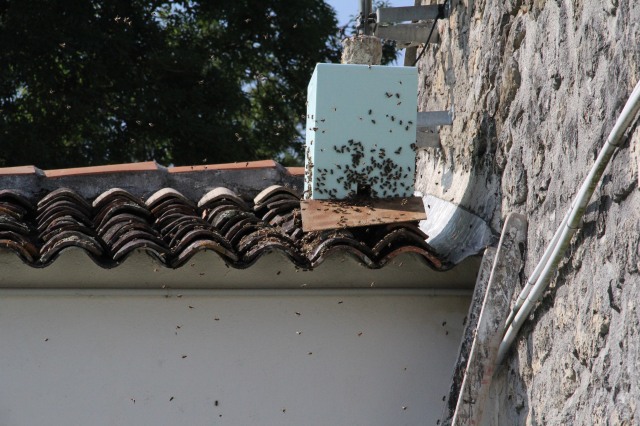
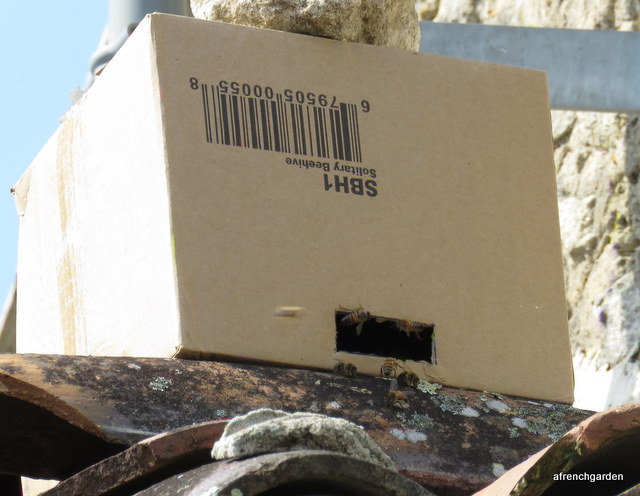

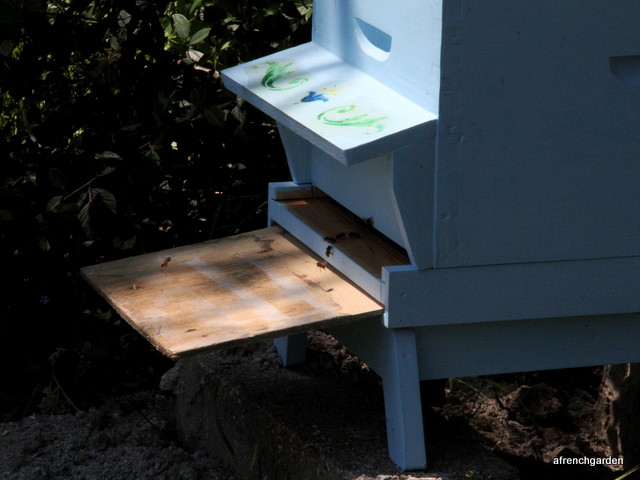
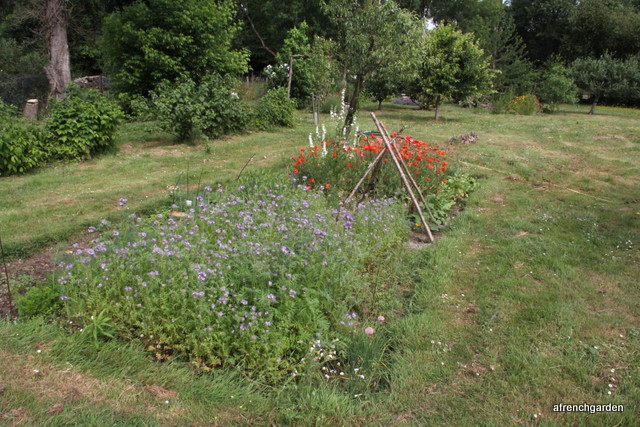

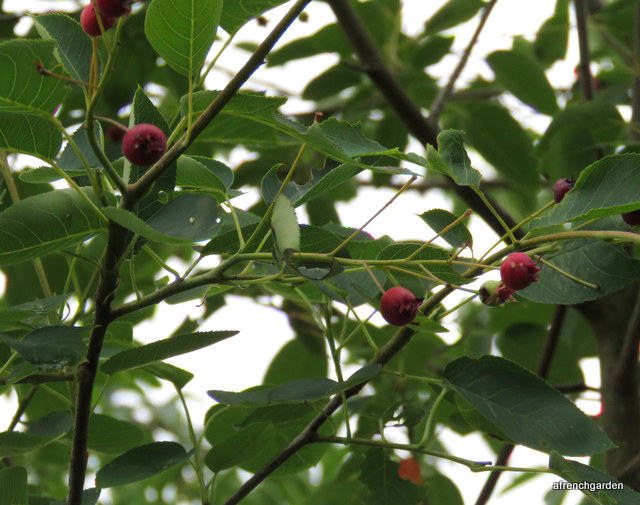
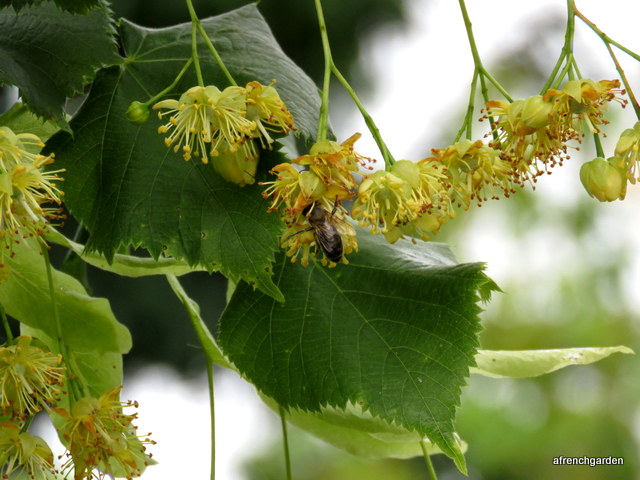
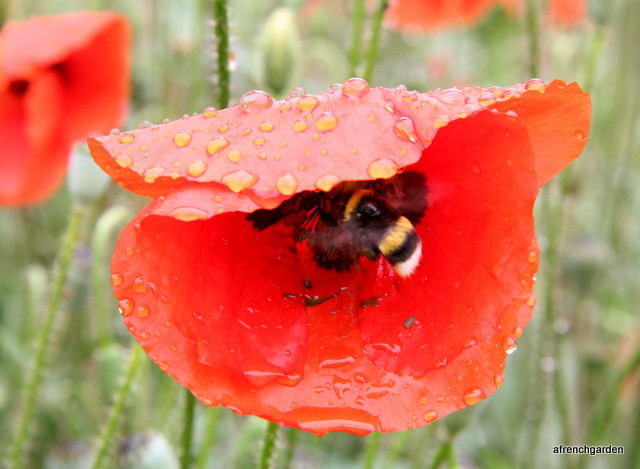
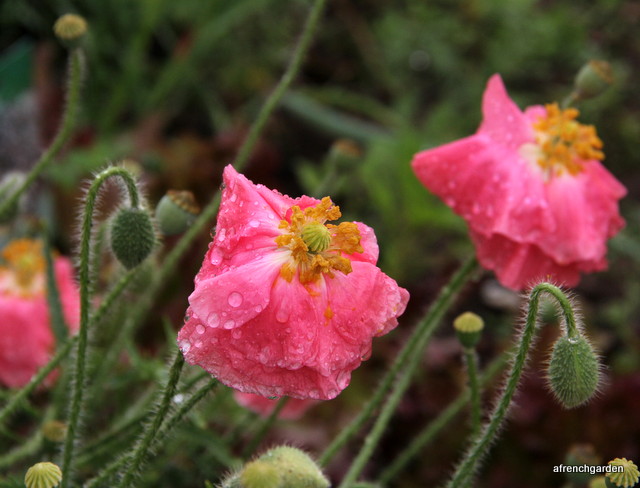

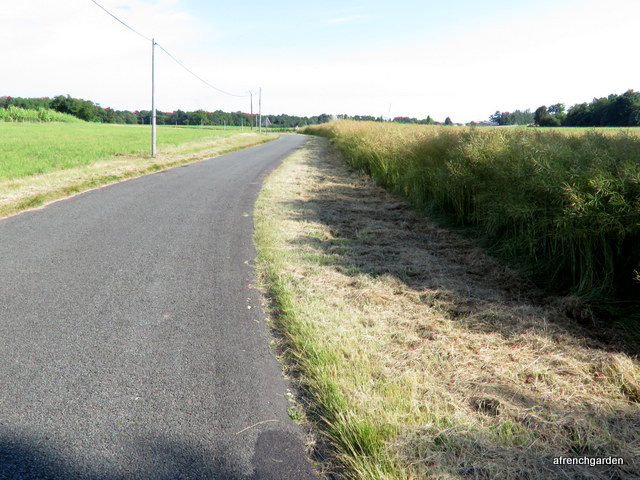
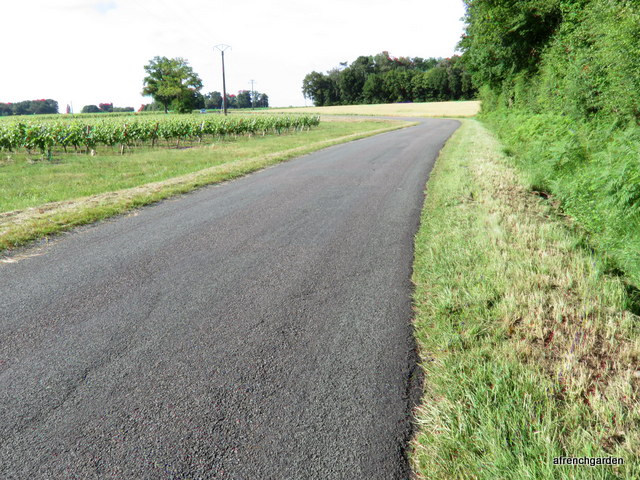



I’m glad to see that your bees are settling in. They are indeed a treasure to have in your garden.
LikeLike
We are already very fond of them and they all seem to be very gentle. Amelia
LikeLiked by 1 person
Great hare photos!
LikeLiked by 1 person
As I have only just started getting your emails I can’t help wondering who Kourosh is? And who you are? A botanist perhaps? Ethologist? Biologist? ??
LikeLike
Kourosh is my husband and I am a retired microbiologist. All that I see in the garden is through observation and not training. We have only started the garden nine years ago but the more variety of plants we include the more interest the garden gives us back. There is always something to watch in the garden. Amelia
LikeLike
I’ve noticed that the bees love the poppy pollen. Makes me wonder if its opiate quality makes it desirable from a bee’s perspective.
LikeLike
These poppies are not the same species as the poppies grown for opium so I would tend to think the bees were looking for high quantities of high protein pollen rather than just a high, but who knows? Amelia
LikeLiked by 1 person
Seems like you’ll soon have a commercial apiary, Amelia, if you keep attracting in all the local swarms! You make it sound really easy! I also think the above comment about opiates is an interesting one. I only discovered this week that eating poppy seed ( which I’ve historically used in our home made bread), would yield a positive result on a blood test for opiates, within half an hour or so – this made me wonder if its why I often go into a post prandial zizzy mode after lunch… But maybe indeed the bees are gaining something of phamacological benefit from it.
Best wishes
Julian
LikeLike
I believe the commercial poppy seeds are harvested from the same species of poppy that is grown for opiates. What I am not sure of is whether the other species produce significant quantities of opiates. Amelia
LikeLiked by 1 person
I love the whole idea of an extension board for pollen laden bees, excellent work!
LikeLike
Kourosh will be happy to hear that! Amelia
LikeLike
I get a lot of bumblebees on my phacelia but rarely see a honey bee or any other type of bee. That said, I know that there are beehives which might be just close enough but perhaps they prefer someone else’s garden!
LikeLike
I’ve probably just got an over active imagination and was expecting a bustling crowd of different bees and butterflies. Amelia
LikeLike
Well, you are still doing the bumble bees a favour 🙂
LikeLike
Absolutely! The bumbles are the ones that keep me company even when there is not much sun and the temperatures are too low for other bees.
LikeLike
That’s great!
LikeLiked by 1 person
Thank you for the blog mention. I think you’ll probably have to net the Amelachier because they are a favorite of many birds and they take them so quickly that I have a hard time just getting a photo of the fruit.
I’d like to know what the “jewel” is in that piece of bamboo!
LikeLike
I don’t really mind sharing with the birds as they give us such a lot of pleasure, I was just so surprised that they were edible and tasted so good. As for my “jewel”, so little is known about the wild bees and we are into a new era now where people can take digital photographs and share them with the world. Such a short time ago nature lovers might have drawn their discoveries for personal pleasure but few people would see them. Amelia
LikeLiked by 1 person
Koroush appears to be a natural at beekeeping. The idea of the cardboard box to recover stragglers is brilliant – why let those girls die all in a huddle alone? And that bottom board is perfect. I love watching the overloaded girls crash land. I want to high-five mine when I can see their pollen baskets overflowing or know their honeysack is bursting. Of course their sisters don’t even stop to nod and smile because they’re off after their own treasure!
I wouldn’t be sure that the 2nd swarm is smaller just because you missed seeing them congregating. It’s pretty common for bees to swarm in the morning – hang about in a nearby tree while the scouts do their thing and then move to their new home in the late afternoon. You may have just caught the end of the final move. You’ll just have to wait until they are settled and Koroush feels it’s time to do an inspection before you know how strong it is. Waiting and wondering what the queen and her court are doing is one of those sweet torments of beekeeping!
LikeLike
I think you might be right about the second swarm. So far there is a lot of activity and it always appears very busy. He will be able to see when it is time to change it into its proper hive. Amelia
LikeLike
Thankyou for explaining about yourself and Koroush. I hope you didn’t think it was rude of me to ask. Your blog is SO INTERESTING! As an amateur botanist/entomologist I find it enthralling.
LikeLike
Thank you! I grew up screaming at spiders and treating insects with the contempt they deserved. It was only when the solitary bees became interested in the garden and I saw how beautiful they were that I started looking at things from another angle. Amelia
LikeLike
It sounds as though your husband is quite devoted to his bees! Lovely shot of the hare. We see them nearby after the mowing of hay meadows is done, as they are well-hidden before. There are strict rules about mowing times here, aimed at preserving flower seed and habitat for wildlife, especially birds that nest on the ground. It seems early June is the latest time to mow if other grasses and flowers are to have the time to flower and set seed again before the autumn.
LikeLiked by 1 person
It must be lovely having hay meadows nearby. These are very precious environments and I know the mowing must be coordinated to allow the local wild flowers to bloom. However, roadside verges and waste plots can also provide an environment for many insects, such as nesting bumble bees, especially if they are cut much later in the year. Amelia
LikeLiked by 2 people
I love the red poppy umbrellas and the hare.
LikeLike
I love my patch of red poppies as it draws so many bees for me to watch. Amelia
LikeLike
Much going on there! The dropping vs. upfacing poppies have gotten me thinking about my hellebores. I have been trying to favor the ones that face outward at least rather than hang. Now I’m thinking of them as protected pollen pantries during the earliest part of spring when the weather can be wet.
LikeLike
That’s a good point. I’ve got quite a lot of Hellebores – all downward facing. This presents no problem to the bumble bees but although I have never seen a honey bee on Hellebore I read that Hellebore scores 2/3 for both pollen and nectar for honey bees. Amelia
LikeLike
The hare is wonderful. I haven’t seen one for quite a few years so nice to see yours. I have to rush out tomorrow and check my Amelanchier, as I was planning to try them for they first time, just as you were!
LikeLike
My Amelanchier was bought here in France with no thought for the fruit, I hope yours tastes as good. Amelia
LikeLiked by 1 person
Lovely engaging post as always Amelia, I grow lots of Phacelia here and in one part of the my veg garden a whole bed of it as I am part way to redesigning the whole area and its reseeded from the over winter soil improver crop. We have lots of small Bumbles visiting and some honey bees and so far rarely a Butterfly but my garden is exposed and Butterflies are not regulars. Wonderful shots of the Hare, he is very handsome.
LikeLike
I’ve got the Phacelia in between my saffron and I am hoping it will work as a soil improver. I should think it should as long as I don’t pull it out roots and all. Amelia
LikeLike
Amelia I got distracted and then lost my train of thought when I replied before. I also grow lots of Nepeta and that attracts just as much if not more than the phacelia, but thats not scientific just a passing observation. I try to grow a green manure to improve my sandy soil and then as it disintegrates in the cold lay it on top to keep cats off my veg plot in the winter.
LikeLike
Interesting, my soil is sandy and very porous. I’ll have to try and expand my green manure this year.
LikeLike
I believe the opium poppy (P.somniferum) is the only poppy variety to contain morphine. For more information about the problems that can arise with poppy seeds, have a look at this article on my blog: https://philipstrange.wordpress.com/2014/05/19/the-risks-of-eating-poppy-seed-bread/
LikeLiked by 1 person
I thought I had read that somewhere, now I remember where! Thanks for the info. Amelia
LikeLike
Much to my dismay they’ve mowed a lot of the verges here too just when the wild flowers were at their best too 😦
LikeLike
It is done without clearly thinking and I hope that it will be rectified in the future. Amelia
LikeLiked by 1 person
My phacelia attracts bumble bees, bees and hover flies. So far no butterflies. I love having it in the garden. And it is good as a cut flower, too, with a gentle, sweet fragrance.
LikeLike
I’ve never thought of it as a cutting flower but you are right it would make a beautiful addition to an arrangement. Amelia
LikeLiked by 1 person
It has a surprisingly lovely fragrance.
LikeLike
I hadn’t really noticed the perfume. Mine has a “wild” fragrance – not a sweet one.
LikeLiked by 1 person
That’s real interesting about the ‘diamond’ in the bamboo tube. I wonder if it’s purposeful? Like some kind of protection from predators.
My Phacelia patch is late this year. Deer have been sampling it. Last year I was disappointed in the honeybee pollination too…until the blackberries were done blooming. Then the honeybees got to work on the Phacelia. I think they prefer blackberry blossoms…they are, after all, Oregon’s largest nectar flow.
As far as the road trimming goes, you may be lucky they don’t poison like our city and county does. At least the flowers will come back and you don’t have to worry about your bees bringing back poison into the hive. A fellow beekeeper a few miles south of me lost all three of his hives. He can’t say it was road poison for sure, but their tongues were sticking out, so it was probably some kind of poison.
LikeLike
I am sure the diamond is caused by cellophane-like material much like the tubes being sealed with leaves or earth by some bees. I have seen similar flat glass-like seals but I have never actually seen the bee that does it. Our bees are bringing in black pollen from the poppies in the morning and also a bright yellow pollen throughout the day. I don’t know where the bright yellow comes from as there is a lot of blackberries (cream coloured) and the chestnuts are in flower. There are only a few on the Phacelia.
It really does seem barbaric to spray the roadsides. Amelia
LikeLiked by 1 person
Pingback: Honey Bees | a french garden
I’ve read your bee info with interest. I hope you dont mind me asking – I’m a Wiltshire beekeeper and will be staying in La Foye de Vinax from Aug1-8th and wondered if you ever had visitors to look at your bees or garden? I would love to if poss and could bring a clean beesuit. Thank you
LikeLike
You would be more than welcome, we love talking about the garden and the bees. We are about an hour and a half from La Foye de Vinax and we could give you more details if you email us at afrenchgarden@gmail.com
Amelia
LikeLike